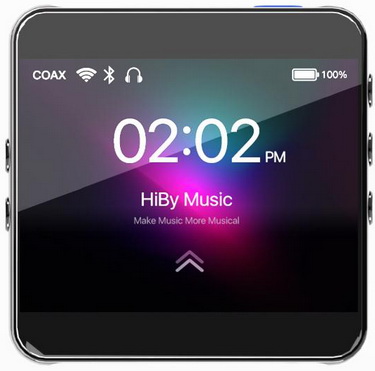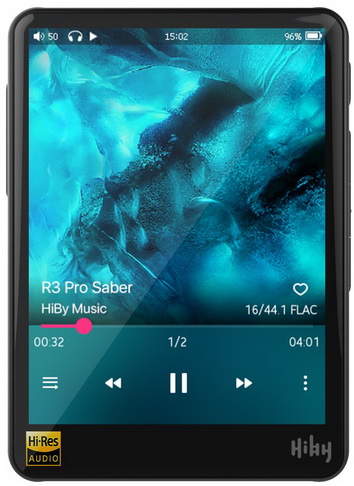Connecting a Music player that contains a Headphones DAC to Speakers
Hi all
The companyh HiBy makes 2 nice Music Players:
HiBy R2:

HiBy R2 MP3 Network Streaming Music Player HiRes Lossless Digital Audio Tidal MQA 5Gwifi LDAC DSD web radio Bluetooth 5.0|HiFi Players| - AliExpress
HiBy R3Pro:

HiBy R3Pro MP3 Network Streaming Music Player HiRes Lossless Digital Audio Tidal MQA 5Gwifi LDAC DSD web radio dual CS43131|HiFi Players| - AliExpress
The HiBy R2 is based on ES9218,
and the HiBy R3Pro is based on 2x CS43131.
These 2 DAC chips are DACs that include a built-in Headphone Amplifier.
In my case, I do not use Headphones, only Speakers.
I have 2 Yamaha HS7 monitors (amplified), that I wish to connect one of these players to.
My question:
Does the fact that these 2 music players contain a Headphones DAC and not a regular DAC, affect/degrade the sound in any way,
when connecting one of these players to amplified speakers instead of to headphones?
Thank you
Hi all
The companyh HiBy makes 2 nice Music Players:
HiBy R2:

HiBy R2 MP3 Network Streaming Music Player HiRes Lossless Digital Audio Tidal MQA 5Gwifi LDAC DSD web radio Bluetooth 5.0|HiFi Players| - AliExpress
HiBy R3Pro:

HiBy R3Pro MP3 Network Streaming Music Player HiRes Lossless Digital Audio Tidal MQA 5Gwifi LDAC DSD web radio dual CS43131|HiFi Players| - AliExpress
The HiBy R2 is based on ES9218,
and the HiBy R3Pro is based on 2x CS43131.
These 2 DAC chips are DACs that include a built-in Headphone Amplifier.
In my case, I do not use Headphones, only Speakers.
I have 2 Yamaha HS7 monitors (amplified), that I wish to connect one of these players to.
My question:
Does the fact that these 2 music players contain a Headphones DAC and not a regular DAC, affect/degrade the sound in any way,
when connecting one of these players to amplified speakers instead of to headphones?
Thank you
Last edited:
The music players should likely sound about the same as with headphones if the headphone output is connected to the line level inputs of self powered speakers. Could even be the player will sound better than with headphones, since it is driving a load that probably draws less current than headphones would.
All the above having been said, music players using dacs with built-in headphone amps are optimized to use as little power as possible in order to run longer before needing the batteries recharged or replaced. That type of optimization is probably not same as optimizing for best sound quality instead. But if you like the sound of the player then you should be good.
All the above having been said, music players using dacs with built-in headphone amps are optimized to use as little power as possible in order to run longer before needing the batteries recharged or replaced. That type of optimization is probably not same as optimizing for best sound quality instead. But if you like the sound of the player then you should be good.
Last edited:
Thank you Mark
BTW it reminds me another issue regarding DAC Power - DACs that are AC Powered (like AC Powered Amplifiers).
Did you feel a difference between an AC Powered DAC and a regular DC Powered DAC?
I would only be able to hear them after I buy one of them.
That's a good point.All the above having been said, music players using dacs with built-in headphone amps are optimized to use as little power as possible in order to run longer before needing the batteries recharged or replaced. That type of optimization is probably not same as optimizing for best sound quality instead.
BTW it reminds me another issue regarding DAC Power - DACs that are AC Powered (like AC Powered Amplifiers).
Did you feel a difference between an AC Powered DAC and a regular DC Powered DAC?
Actually I haven't heard any of these 2 players yet..But if you like the sound of the player then you should be good.
I would only be able to hear them after I buy one of them.
Did you feel a difference between an AC Powered DAC and a regular DC Powered DAC?
Ultimately, dac chips only run on DC power. If we start with AC then it depends on how well we do the conversion to DC.
Aren't there DAC chips that their Digital side is DC Powered and their Analog side is AC (and Dual Rail) Powered?Ultimately, dac chips only run on DC power.
(did I mix bewteen AC and Dual Rail?
do both always come together, or are separate?)
Last edited:
Digital side is usually +3.3VDC, single rail. Analog side is usually dual rail, sometimes +-15VDC. Both analog and digital sides have the grounds connected together at the dac chip. If the Analog side is not dual rail, then usually DC blocking caps or audio transformers have to be used to connect the analog outputs to, say, an external amplifier or maybe a preamp, etc.
Last edited:
I see.
So I incorrectly mixed between AC and Dual Rail, my apology.
So in that case, allow me to fix my question:
From your experience,
did you feel a difference between a DAC that its Analog side is Dual Rail powered vs a DAC that its Analog side is Single Rail Powered?
(I ask this to know if it's worth to find and buy one Dual Rail)
From what I was told here in the past, regarding Amplifiers,
DC blocking capacitors prevent getting to lower frequencies,
and avoiding DC blocking capacitors enables getting to lower frequencies..
But the DACs that I heard so far, can get to prertty nice lo frequencies, so I wonder is it really possible to go even further..
So I incorrectly mixed between AC and Dual Rail, my apology.
So in that case, allow me to fix my question:
From your experience,
did you feel a difference between a DAC that its Analog side is Dual Rail powered vs a DAC that its Analog side is Single Rail Powered?
(I ask this to know if it's worth to find and buy one Dual Rail)
From what I was told here in the past, regarding Amplifiers,
DC blocking capacitors prevent getting to lower frequencies,
and avoiding DC blocking capacitors enables getting to lower frequencies..
But the DACs that I heard so far, can get to prertty nice lo frequencies, so I wonder is it really possible to go even further..
Last edited:
Dual rail is mostly to allow removal of dac chip DC offset from ground without using a cap or a transformer to do it. Sound can be cleaner that way, but unless dac is a very good one where every little imperfection has been dealt with as much as possible, a suitable DC blocking cap in the signal path may not sound that much more imperfect. With cheap dacs usually there are so many other little imperfections, one more in the form of a DC blocking cap doesn't make a huge relative difference. So, maybe single rail analog output can suffice. Does that make sense?
YesDoes that make sense?
BTW,
is the only way to get a Dual Rail power (+V,0,-V) is to start with AC Dual Rail,
or it's possible to take some DC (Single Rail), and then using some component to make it Dual Rail?
(if the second option is indeed possible, is it the same uality as starting with AC, or inferior to it and hence should not be used?)
Dual rail can be generated from a single rail. Switching power supplies do that sort of thing all the time. The problem with switchers is that they tend to make a lot electrical noise that then has to be managed. It can be done, but it can be more trouble than its worth sometimes.
Probably better and easier to just to start with AC line power and use a power transformer with two or three separate secondary windings.
If you are interested, I think the forum store may sell Jan Didden's 'Silent Switcher' which can generate +-15 and +5v (or maybe +3.3v) from a 5v wall wart output. The biggest problem with that is wall warts usually generate a lot common mode RF on the their outputs. That RF hash can go right past silent switcher through the ground connections. On the other hand, if Silent Switcher is used with a linear power supply produced +5v as the input, then it might be a lot more suitable for generating dual rails for a dac. Of course, that type of switching power supply has a cost too, and IMHO is not as good for most dac purposes as a good dual rail or 3-rail linear power supply derived from separate power transformer windings. If battery operation is a requirement, then something like Silent Switcher might be a good choice.
Probably better and easier to just to start with AC line power and use a power transformer with two or three separate secondary windings.
If you are interested, I think the forum store may sell Jan Didden's 'Silent Switcher' which can generate +-15 and +5v (or maybe +3.3v) from a 5v wall wart output. The biggest problem with that is wall warts usually generate a lot common mode RF on the their outputs. That RF hash can go right past silent switcher through the ground connections. On the other hand, if Silent Switcher is used with a linear power supply produced +5v as the input, then it might be a lot more suitable for generating dual rails for a dac. Of course, that type of switching power supply has a cost too, and IMHO is not as good for most dac purposes as a good dual rail or 3-rail linear power supply derived from separate power transformer windings. If battery operation is a requirement, then something like Silent Switcher might be a good choice.
Last edited:
- Status
- This old topic is closed. If you want to reopen this topic, contact a moderator using the "Report Post" button.
- Home
- Source & Line
- Digital Line Level
- Connecting a Headphones DAC to Speakers